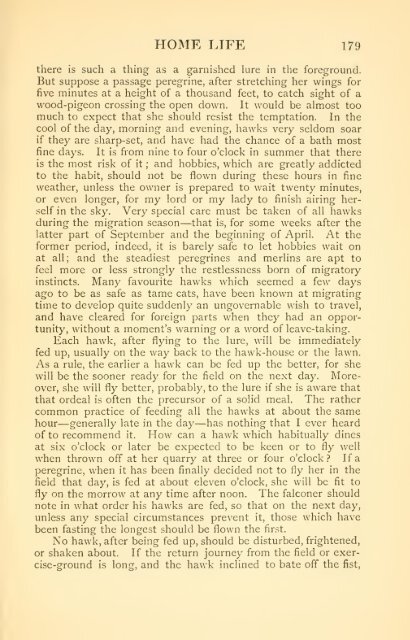The art and practice of hawking - Modern Prepper
The art and practice of hawking - Modern Prepper
The art and practice of hawking - Modern Prepper
- No tags were found...
You also want an ePaper? Increase the reach of your titles
YUMPU automatically turns print PDFs into web optimized ePapers that Google loves.
HOME LIFE 179<br />
there is such a thing as a garnished lure in the foreground.<br />
But suppose a passage peregrine, after stretching her wings for<br />
five minutes at a height <strong>of</strong> a thous<strong>and</strong> feet, to catch sight <strong>of</strong> a<br />
wood-pigeon crossing the open down. It would be almost too<br />
much to expect that she should resist the temptation. In the<br />
cool <strong>of</strong> the day, morning <strong>and</strong> evening, hawks very seldom soar<br />
if they are sharp-set, <strong>and</strong> have had the chance <strong>of</strong> a bath most<br />
fine days. It is from nine to four o'clock in summer that there<br />
is the most risk <strong>of</strong> it ; <strong>and</strong> hobbies, which are greatly addicted<br />
to the habit, should not be flown during these hours in fine<br />
weather, unless the owner is prepared to wait twenty minutes,<br />
or even longer, for my lord or my lady to finish airing herself<br />
in the sky. Very special care must be taken <strong>of</strong> all hawks<br />
during the migration season—that is, for some weeks after the<br />
latter p<strong>art</strong> <strong>of</strong> September <strong>and</strong> the beginning <strong>of</strong> April. At the<br />
former period, indeed, it is barely safe to let hobbies wait on<br />
at all; <strong>and</strong> the steadiest peregrines <strong>and</strong> merlins are apt to<br />
feel more or less strongly the restlessness born <strong>of</strong> migratory<br />
instincts. Many favourite hawks which seemed a few days<br />
ago to be as safe as tame cats, have been known at migrating<br />
time to develop quite suddenly an ungovernable wish to travel,<br />
<strong>and</strong> have cleared for foreign p<strong>art</strong>s when they had an opportunity,<br />
without a moment's warning or a word <strong>of</strong> leave-taking.<br />
Each hawk, after flying to the lure, will be immediately<br />
fed up, usually on the way back to the hawk-house or the lawn.<br />
As a rule, the earlier a hawk can be fed up the better, for she<br />
will be the sooner ready for the field on the next day. Moreover,<br />
she will fly better, probably, to the lure if she is aware that<br />
that ordeal is <strong>of</strong>ten the precursor <strong>of</strong> a solid meal. <strong>The</strong> rather<br />
common <strong>practice</strong> <strong>of</strong> feeding all the hawks at about the same<br />
hour — generally late in the day—has nothing that I ever heard<br />
<strong>of</strong> to recommend it. How can a hawk which habitually dines<br />
at six o'clock or later be expected to be keen or to fly well<br />
when thrown <strong>of</strong>f at her quarry at three or four o'clock If a<br />
peregrine, when it has been finally decided not to fly her in the<br />
field that day, is fed at about eleven o'clock, she will be fit to<br />
fly on the morrow at any time after noon. <strong>The</strong> falconer should<br />
note in what order his hawks are fed, so that on the next day,<br />
unless any special circumstances prevent it, those which have<br />
been fasting the longest should be flown the first.<br />
No hawk, after being fed up, should be disturbed, frightened,<br />
or shaken about. If the return journey from the field or exercise-ground<br />
is long, <strong>and</strong> the hawk inclined to bate <strong>of</strong>f the fist,

















